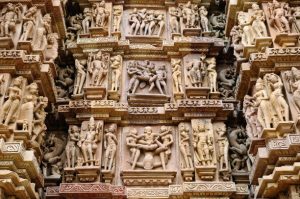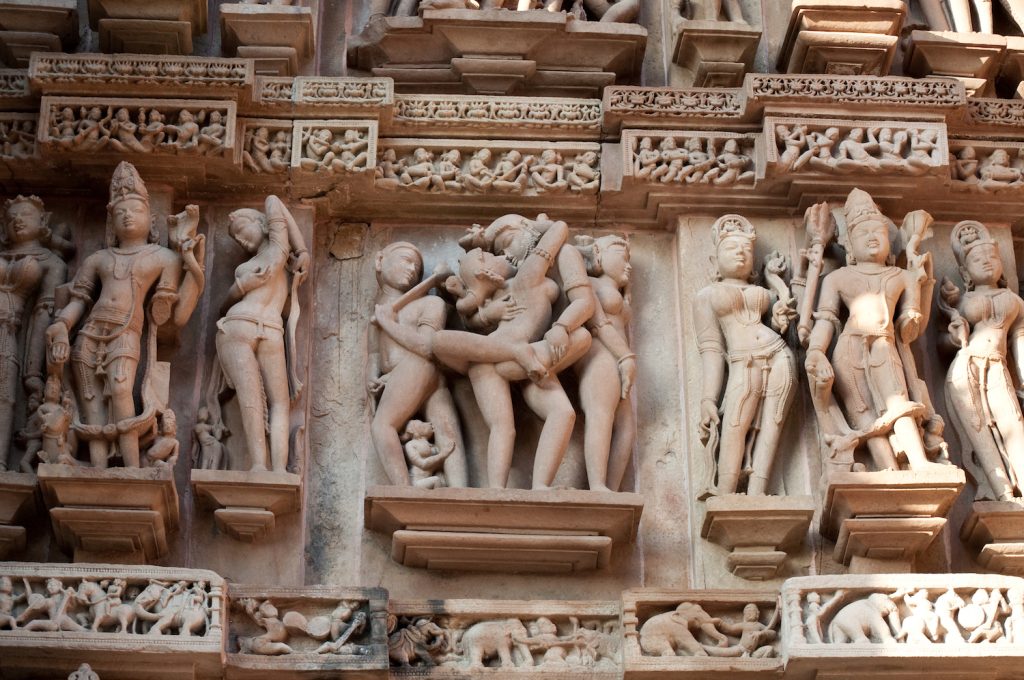UNESCO has declared 16 Sites as World Cultural Heritage Sites in India, and Khajuraho is one of them. Khajuraho, once the capital of the Chandella Rajputs, is now a village in the Chhatarpur district of Madhya Pradesh. The area witnessed great artistic and cultural activity from the 9th to the 12th century A.D. The Chandella rulers of the region were great patrons of art and culture. The magnificent temples are one such significant contribution. It is commonly believed that over 80 temples were constructed by the Chandellas, although only about twenty-five survive today
Temples are divided into three groups
The Western group consists of the Chausauth-yogini temple, Lalgaun Mahadev temple, Varaha temple(900-925ad), Matangeshwara temple (900-925ad), Parvati temple (950-1000ad), Lakshmana temple (930-950ad), Vishwanatha temple (1002ad), Nandi shrine, Chitragupta temple (early 11thcentury), Devi Jagdambi temple (early 11th century), ruined Shiva temple, Kandariya Mahadeva temple (1025-50ad).
The Eastern group consists of the Brahma Temple (900 ad), a statue of Hanuman, Vamana temple (1050-75ad), Shantinath temple, Parshwanath temple (mid 10th century), Adhinath temple (late 11thcentury), Ghantai temple (late 10th century), Javari temple (1075 to 1100 ad).
The Southern group consists of the Duladeo temple (1100-50ad), and Chaturbhuja temple (early 11th century). There is an Archaeological Museum close to the temple.
An interesting feature of the Khajuraho sculptures is their use of symmetry and balance. Many of the sculptures are symmetrical, with two or more figures depicted in a perfectly balanced composition. This symmetry is not just an aesthetic choice but also serves to convey a sense of harmony and balance in the universe.
OSHO wrote in Vigyan Bhairav Tantra Vol 1 pg 415, “Have you seen Khajuraho? Or if you have not seen Khajuraho, you might have seen pictures of the Khajuraho temple. Then look at the faces, at couples making love. Look at the faces, the faces look divine. They are in the act of sex, but their faces are as ecstatic as any Buddha’s face. What is happening to them? This sex is not cerebral. They are not making love through the head; they are not thinking about it. They have dropped down from the head. Their focus has changed.”
“Because of this dropping from the head, the consciousness has moved to the genital area. The mind is no more. The mind has become a no-mind. Their faces have the same ecstasy as a Buddha has. This sex has become a meditation.”
It is considered that these temples are a celebration of womanhood as they depict sculptures of heavily ornamented broad-hipped and busty but well-proportionate women (apsaras) adorning the temple walls. The well-contoured bodies of the nymphs grab attention and they can be seen engaging in activities like putting on make-up, washing their hair, playing games and knotting and unknotting their girdles” (Cunningham, 2016) These temples were made between the 10-13th centuries ie before Islamic and Victorian views on sex influenced India.
One of the most asked questions about the sculptures in Khajuraho’s temples is why do they have such erotic sculptures on their walls. Here I would like to clarify that these erotic sculptures are only on the outer walls of temples. It can be overwhelming or annoying for some people to see different sexual positions on temple walls. There seem to be some myths, reasons, and stories behind these sculptures on temple walls.

Following are a few most popular stories I am sharing that I have come across during and after my visit to Khajuraho.
The story associated with Chandela king
The most popular story is associated with the Chedela king Chandravarman. According to the legend, a beautiful lady named Hemavati was taking a bath in a pond full of lotus flowers on a full moon night. The Moon God Chandrama got fascinated with her beauty and approached her.
After their romantic encounter, Hemavati got pregnant and to hide her shame of being an unwedded mother, she went into the jungle and gave birth to a male child. When Chandrama came to know about the child he gave him a boon that he will become a king. Hemavati named the boy Chandravarman after the moon God and raised the child single handle.
Chandravarman knew about her mother’s story and built the temples when he became king. He ordered to engrave erotic sculptures on temple walls. Some say it is to portray sex as a natural act among human beings and others say these are just to show the pointlessness of these acts.
Maithunas and Tantric cult story
The second story comes from the local guide we engaged for our temple tour. He said the erotic statues on temple walls were carved due to the “Tantric” influence. He told us about the “Chausath Yogini temple” to prove his point.
This temple of “Devi” is also in the Western group of temples and has mysticism around it. Chausath Yogini temple is considered one of the most important temples in the Tantric cult.
He told us that men and women shown in different mating positions are the “Maithunas”. The Maithuns were the people who followed Tantra and Tantric practices in which sexual union is one of the important rituals. These sculptures of Maithuns were made to show their religious beliefs.
Maithuns also believed that these relations between men & women are not just a physical union, but it is a union in which men and women transfer their internal energy to each other which is a very important part of Tantric practices. Guide told us that during the mating time, they attain the divine form of Shiva and Shakti. Maithuns considered it the ultimate bliss which gives spiritual energy and a way to attain Moksha.
To influence people for family life
The third story has a different angle. According to this, during the 9th-10th century, lots of people were influenced by Jainism and Buddhism. They were leaving their homes to live the life of monks. So to discourage them and to evoke their physical desires to live family life these erotic sculptures were made on temple walls.
Another similar concept says that in those days young boys were sent to Gurukuls, where they live in solitude away from family life. These boys don’t have any contact with women and girls, so they do not know about physical relations. Before going into social life after completion of education, these young men were sent to these temples to understand this part of life. The metaphors were made to attract and educate these young men about family life.
Spirituality
One story says that these statues are symbolic of human desire. These sculptures are only on the outer wall and the inner parts of temples have statues of Vishnu or Shivalingam or sometimes empty. This symbolizes that you leave the lust and desire outside when you enter the temple, which means you should be free from desires.
It symbolizes that a person has completed the worldly deeds of performing duties, overcoming money matters, overcoming sexual desire, and now it is the time to attain Moksha. This way a person can pray to God with full attention to attain spirituality.
Sex which is Senseous
The faces of idols carry a divine serenity on their faces. There isn’t a trace of amour in their demeanour. For them, sex is not a compulsive act but a sense of union formed by love. In his book, Kamasutra, Vatsyayana writes, “The one who masters all 84 postures elevates himself from the clutches of primal instincts.”
One thing I can vouch for myself: you can’t feel sensuality anywhere in these temples. Rather, you feel the release of suppressed energy. The sense is very different from seeing nudity in pornography. These temples resemble our world in the miniature form where everything is inclusive.





